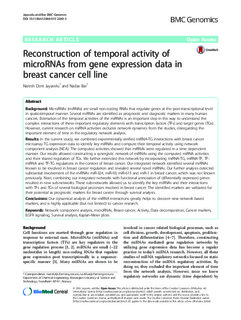| dc.contributor.author | Doni Jayavelu, Naresh | |
| dc.contributor.author | Bar, Nadav | |
| dc.date.accessioned | 2016-02-03T12:23:03Z | |
| dc.date.accessioned | 2016-05-31T12:43:56Z | |
| dc.date.available | 2016-02-03T12:23:03Z | |
| dc.date.available | 2016-05-31T12:43:56Z | |
| dc.date.issued | 2015 | |
| dc.identifier.citation | BMC Genomics 2015, 16(1):1077 | nb_NO |
| dc.identifier.issn | 1471-2164 | |
| dc.identifier.uri | http://hdl.handle.net/11250/2390925 | |
| dc.description.abstract | Background
MicroRNAs (miRNAs) are small non-coding RNAs that regulate genes at the post-transcriptional level in spatiotemporal manner. Several miRNAs are identified as prognostic and diagnostic markers in many human cancers. Estimation of the temporal activities of the miRNAs is an important step in the way to understand the complex interactions of these important regulatory elements with transcription factors (TFs) and target genes (TGs). However, current research on miRNA activities excludes network dynamics from the studies, disregarding the important element of time in the regulatory network analysis.
Results
In the current study, we combined experimentally verified miRNA-TG interactions with breast cancer microarray TG expression data to identify key miRNAs and compute their temporal activity using network component analysis (NCA). The computed activities showed that miRNAs were regulated in a time dependent manner. Our results allowed constructing a synergistic network of miRNAs using the computed miRNA activities and their shared regulation of TGs. We further extended this network by incorporating miRNA-TG, miRNA-TF, TF-miRNA and TF-TG regulations in the context of breast cancer. Our integrated network identified several miRNAs known to be involved in breast cancer regulation and revealed several novel miRNAs. Our further analysis detected substantial involvement of the miRNAs miR-324, miR-93, miR-615 and miR-1 in breast cancer, which was not known previously. Next, combining our integrated networks with functional annotation of differentially expressed genes resulted in new sub-networks. These sub-networks allowed us to identify the key miRNAs and their interactions with TFs and TGs of several biological processes involved in breast cancer. The identified markers are validated for their potential as prognostic markers for breast cancer through survival analysis.
Conclusions
Our dynamical analysis of the miRNA interactions greatly helps to discover new network based markers, and is highly applicable (but not limited) to cancer research. | nb_NO |
| dc.language.iso | eng | nb_NO |
| dc.publisher | BioMed Central | nb_NO |
| dc.rights.uri | http://creativecommons.org/licenses/by/4.0/ | |
| dc.subject | Network component analysis – microRNAs – Breast cancer – Activity – Data decomposition – Cancer markers – EGFR signaling – Survival analysis – Kaplan-Meier plots | nb_NO |
| dc.title | Reconstruction of temporal activity of microRNAs from gene expression data in breast cancer cell line | nb_NO |
| dc.type | Journal article | nb_NO |
| dc.type | Peer reviewed | nb_NO |
| dc.date.updated | 2016-02-03T12:23:03Z | |
| dc.source.volume | 16 | nb_NO |
| dc.source.journal | BMC Genomics | nb_NO |
| dc.source.issue | 1 | nb_NO |
| dc.identifier.doi | 10.1186/s12864-015-2260-3 | |
| dc.identifier.cristin | 1323304 | |
| dc.description.localcode | © 2016 Jayavelu and Bar. Open Access This article is distributed under the terms of the Creative Commons Attribution 4.0 International License (http://creativecommons.org/licenses/by/4.0/), which permits unrestricted use, distribution, and reproduction in any medium, provided you give appropriate credit to the original author(s) and the source, provide a link to the Creative Commons license, and indicate if changes were made. The Creative Commons Public Domain Dedication waiver (http://creativecommons.org/publicdomain/zero/1.0/) applies to the data made available in this article, unless otherwise stated. | nb_NO |

